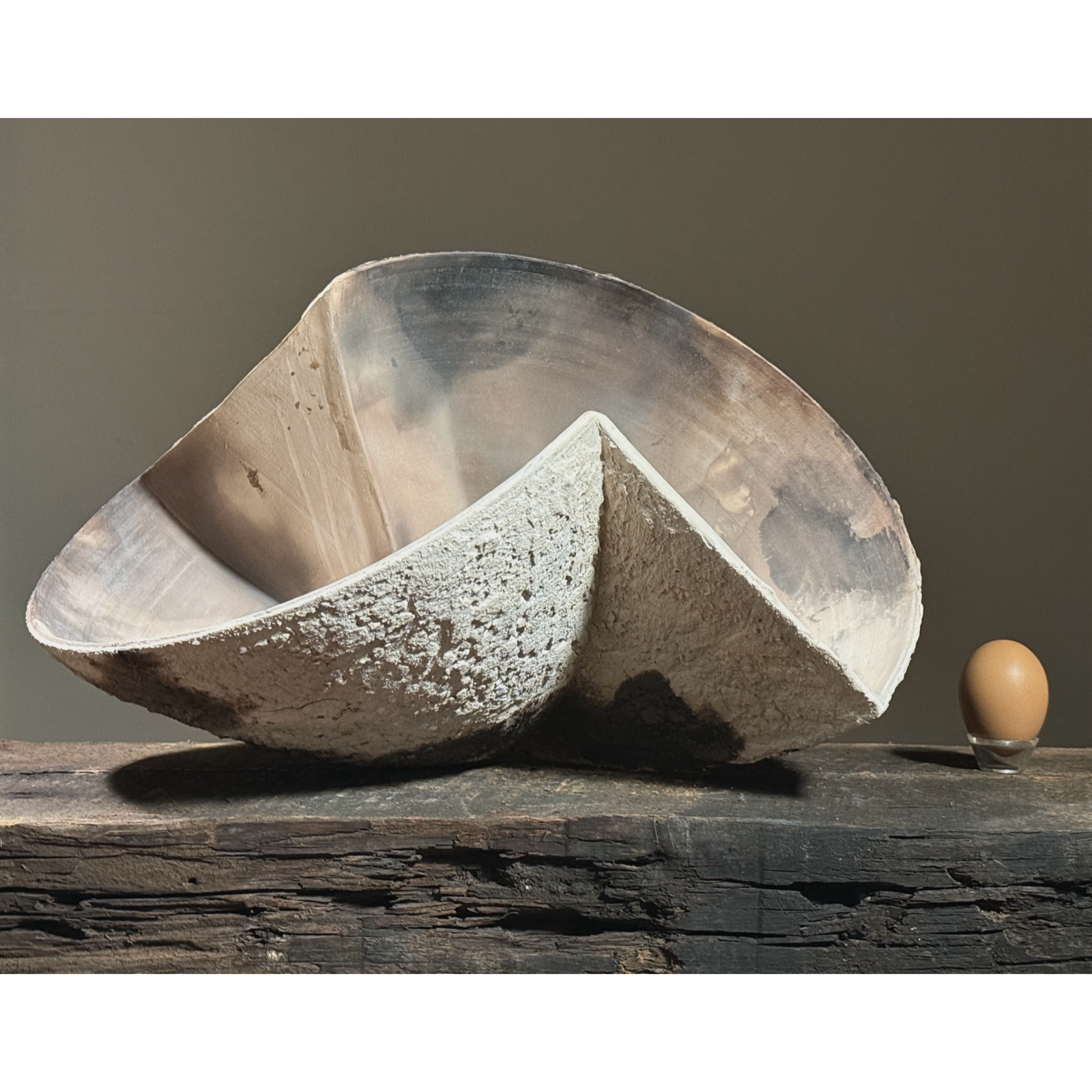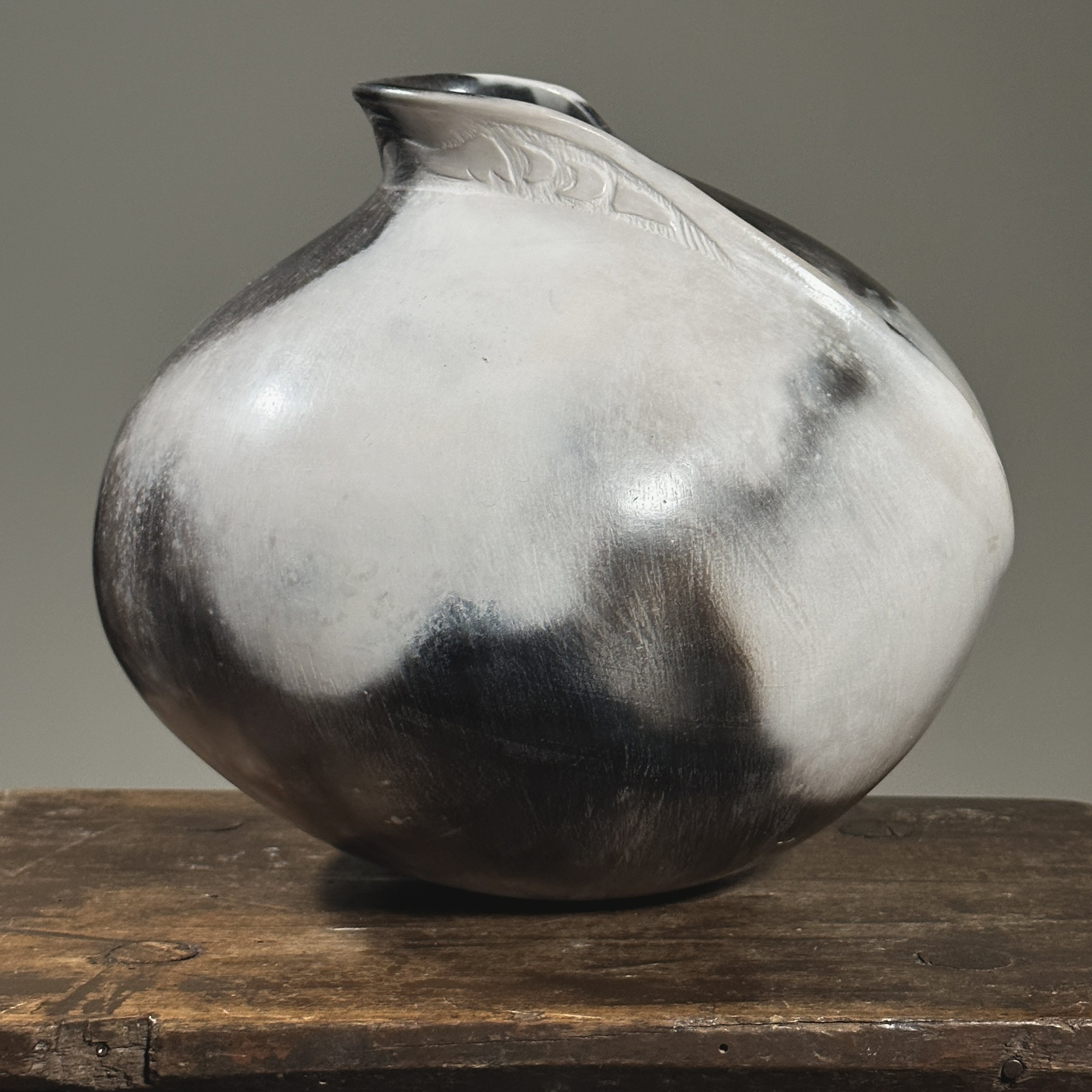 Image 1 of 10
Image 1 of 10

 Image 2 of 10
Image 2 of 10

 Image 3 of 10
Image 3 of 10

 Image 4 of 10
Image 4 of 10

 Image 5 of 10
Image 5 of 10

 Image 6 of 10
Image 6 of 10

 Image 7 of 10
Image 7 of 10

 Image 8 of 10
Image 8 of 10

 Image 9 of 10
Image 9 of 10

 Image 10 of 10
Image 10 of 10











Antique African Nupe Gourd Form Clay Vessel
Antique African Nupe Gourd Form Clay Vessel. Two tiered gourd form clay vessel. Linear incised design along the exterior of the body. Dark brown/maroon hue. Sits on a hand woven reed donut. In used condition with wear consistent with age. Small chip on the rim. Scuffs and scratches are present.
Size: 16”H x 12”D
Among the most distinctive of Nupe pots is the gracefully designed double-tiered container. This type of vessel, which is inspired by the shape of a gourd, is intended for transporting and storing water or palm wine, and it is perfectly designed to accomplish the task. The full belly holds a good amount of liquid, and the narrow neck and funnel-like upper reservoir are ideal for keeping it from sloshing out when the pot is filled or moved. This may explain why such containers were in high demand and widely distributed in the region by Nupe traders.
The potter begins the vessel as she would any round-bottomed pot, forming the base using the convex mold technique. When the clay has dried to leather hardness, she completes the walls of the lower pot using coils. The smaller upper reservoir is molded separately, and when it hardens a hole is cut into its bottom, and it is attached to the lower half with coils that form the neck. Like other Nupe ceramics, it is covered with close-knit, detailed patterns that are applied by burnishing, incising, and roulette work.
In the nineteenth and early twentieth centuries, double-tiered containers were at times made even more elaborate by the addition of hammered brass fittings decorated with delicate repoussé and pointillé designs. On this vessel, these encase the upper tier in netlike bands and run in looping scallops around the lower tier’s broadest expanse. These fittings were the work of a male brass smith who was commissioned to add them to the pot by a wealthy client. Such vessels, with their layers of rich embellishment, were a conspicuous expression of wealth and prestige that resembled brass containers forged for well-to-do patrons, including the royal family and members of the ruling Fulani elite.
Antique African Nupe Gourd Form Clay Vessel. Two tiered gourd form clay vessel. Linear incised design along the exterior of the body. Dark brown/maroon hue. Sits on a hand woven reed donut. In used condition with wear consistent with age. Small chip on the rim. Scuffs and scratches are present.
Size: 16”H x 12”D
Among the most distinctive of Nupe pots is the gracefully designed double-tiered container. This type of vessel, which is inspired by the shape of a gourd, is intended for transporting and storing water or palm wine, and it is perfectly designed to accomplish the task. The full belly holds a good amount of liquid, and the narrow neck and funnel-like upper reservoir are ideal for keeping it from sloshing out when the pot is filled or moved. This may explain why such containers were in high demand and widely distributed in the region by Nupe traders.
The potter begins the vessel as she would any round-bottomed pot, forming the base using the convex mold technique. When the clay has dried to leather hardness, she completes the walls of the lower pot using coils. The smaller upper reservoir is molded separately, and when it hardens a hole is cut into its bottom, and it is attached to the lower half with coils that form the neck. Like other Nupe ceramics, it is covered with close-knit, detailed patterns that are applied by burnishing, incising, and roulette work.
In the nineteenth and early twentieth centuries, double-tiered containers were at times made even more elaborate by the addition of hammered brass fittings decorated with delicate repoussé and pointillé designs. On this vessel, these encase the upper tier in netlike bands and run in looping scallops around the lower tier’s broadest expanse. These fittings were the work of a male brass smith who was commissioned to add them to the pot by a wealthy client. Such vessels, with their layers of rich embellishment, were a conspicuous expression of wealth and prestige that resembled brass containers forged for well-to-do patrons, including the royal family and members of the ruling Fulani elite.
Antique African Nupe Gourd Form Clay Vessel. Two tiered gourd form clay vessel. Linear incised design along the exterior of the body. Dark brown/maroon hue. Sits on a hand woven reed donut. In used condition with wear consistent with age. Small chip on the rim. Scuffs and scratches are present.
Size: 16”H x 12”D
Among the most distinctive of Nupe pots is the gracefully designed double-tiered container. This type of vessel, which is inspired by the shape of a gourd, is intended for transporting and storing water or palm wine, and it is perfectly designed to accomplish the task. The full belly holds a good amount of liquid, and the narrow neck and funnel-like upper reservoir are ideal for keeping it from sloshing out when the pot is filled or moved. This may explain why such containers were in high demand and widely distributed in the region by Nupe traders.
The potter begins the vessel as she would any round-bottomed pot, forming the base using the convex mold technique. When the clay has dried to leather hardness, she completes the walls of the lower pot using coils. The smaller upper reservoir is molded separately, and when it hardens a hole is cut into its bottom, and it is attached to the lower half with coils that form the neck. Like other Nupe ceramics, it is covered with close-knit, detailed patterns that are applied by burnishing, incising, and roulette work.
In the nineteenth and early twentieth centuries, double-tiered containers were at times made even more elaborate by the addition of hammered brass fittings decorated with delicate repoussé and pointillé designs. On this vessel, these encase the upper tier in netlike bands and run in looping scallops around the lower tier’s broadest expanse. These fittings were the work of a male brass smith who was commissioned to add them to the pot by a wealthy client. Such vessels, with their layers of rich embellishment, were a conspicuous expression of wealth and prestige that resembled brass containers forged for well-to-do patrons, including the royal family and members of the ruling Fulani elite.



























